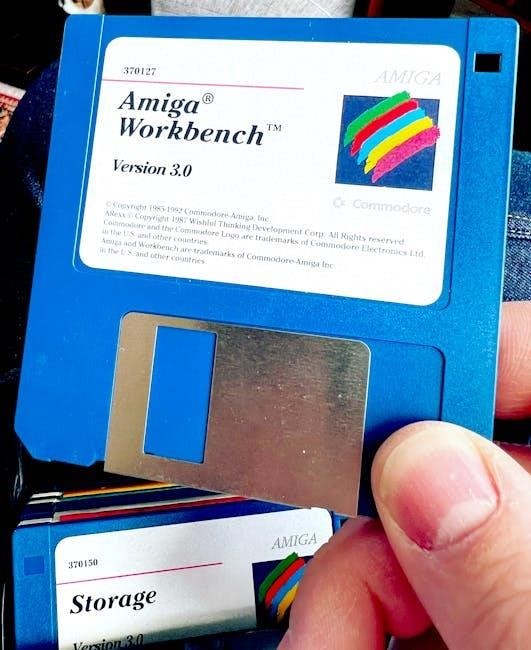The 3-5-3 defense is a versatile scheme with three linemen, five linebackers, and three defensive backs, ideal for aggressive blitzing and stopping spread offenses effectively.
Base Alignment and Positions
The 3-5-3 defense features three defensive linemen, five linebackers, and three defensive backs, aligned to maximize pressure and coverage against modern spread offenses effectively always.

2.1. Defensive Linemen
The three defensive linemen in the 3-5-3 defense are crucial for occupying blockers and stopping the run. They typically consist of two defensive ends and a nose tackle. The defensive ends are often positioned slightly outside the offensive tackles, angled towards the ball, focusing on containment and setting the edge. The nose tackle plays a pivotal role in the middle, occupying the center and disrupting the interior running game. Their primary responsibilities include plugging gaps, creating penetration, and allowing linebackers to flow freely to the ball. Proper alignment and technique are essential for these linemen to control the line of scrimmage effectively in this aggressive defensive scheme.
2.2. Linebackers
The five linebackers in the 3-5-3 defense are the heartbeat of the scheme, providing versatility and athleticism. They are divided into positions such as the middle linebacker, two inside linebackers, and two outside linebackers. Their primary roles include covering the flats, defending the middle of the field, and supporting both the defensive line and secondary. Linebackers must excel in reading offenses, filling gaps, and making tackles. They are often called upon to blitz, creating pressure on the quarterback, while also being disciplined in their assignments to avoid overcommitting. Their ability to cover receivers and stop the run makes them indispensable in this aggressive, multiple-gap defense. Proper alignment and communication among linebackers are critical for the defense’s success, as they must react quickly to various offensive formations and plays.
2.3. Defensive Backs
The three defensive backs in the 3-5-3 scheme are crucial for both pass coverage and run support. They typically consist of one free safety and two cornerbacks, who must be versatile and athletic. Their primary responsibilities include covering wide receivers, providing deep support, and filling gaps in the run game. The free safety often serves as the last line of defense, while the cornerbacks focus on pressuring receivers and defending the flats. Defensive backs must excel in both man-to-man and zone coverages, as the 3-5-3 often employs multiple looks. Their ability to read the quarterback and react quickly is vital, especially in blitz-heavy situations. Proper alignment and communication with linebackers ensure seamless coverage and help prevent big plays.
Roles and Responsibilities
The 3-5-3 defense relies on clear role execution. Defensive linemen occupy blockers, linebackers cover gaps and blitz, and defensive backs secure pass coverage, ensuring balanced defensive performance.
3.1. Defensive Linemen Responsibilities
The defensive linemen in the 3-5-3 defense are primarily responsible for occupying blockers and plugging gaps to stop the run. They must maintain their assigned gaps and prevent offensive linemen from reaching the linebackers. Additionally, they are often called upon to rush the quarterback, especially in blitz packages, where their speed and agility can create pressure. Their ability to control the line of scrimmage is crucial, as it allows the linebackers to flow freely to the ball. Effective play from the defensive line is the foundation of the 3-5-3 defense, enabling the rest of the unit to execute their responsibilities successfully.
3.2. Linebackers Responsibilities
The linebackers in the 3-5-3 defense are the backbone of the unit, responsible for covering the flats, the middle of the field, and supporting both the run and pass defense. They must read the quarterback’s eyes and react quickly to plays, often serving as the primary defenders against screens and draws. Linebackers are also integral in blitz packages, where they are frequently called upon to rush the quarterback or disrupt the backfield. Their versatility allows them to drop into zone coverage or man-up on running backs and tight ends. Effective linebackers in this scheme must be instinctive, athletic, and able to make quick decisions, as they are often the last line of defense before the secondary. Their ability to fill gaps and cover receivers is critical to the defense’s success.

3.3. Defensive Backs Responsibilities
The defensive backs in the 3-5-3 scheme are primarily responsible for covering wide receivers and tight ends, ensuring pass defense is secure. They must excel in both man-to-man and zone coverage, reading the quarterback’s eyes to anticipate throws. Deep support is critical, as they often serve as the last line of defense. Defensive backs must also be disciplined in their assignments, avoiding over-commitment to play-action fakes. In addition, they provide run support by filling gaps when necessary. Their ability to react quickly and make tackles in the open field is vital. Effective communication among the secondary is essential to ensure seamless coverage and limit explosive plays. Defensive backs must be agile, possess strong ball skills, and maintain proper positioning to disrupt passing routes effectively.

Blitz Packages and Pressure Schemes
The 3-5-3 defense is renowned for its aggressive blitz packages, designed to pressure the quarterback from multiple angles. With five linebackers and defensive backs, the scheme allows for creative blitzing combinations. Coaches often employ zone blitzes, where defenders rush while others drop into coverage, creating confusion for the offense. Linebackers and defensive backs can blitz from various depths and angles, overwhelming the offensive line’s blocking assignments. Stunts and slants by the defensive line further complement these pressure schemes, ensuring consistent disruption. The 3-5-3 excels at forcing quick decisions and sacks, making it a high-risk, high-reward strategy. Proper execution and timing are critical to avoid leaving gaps in coverage while generating relentless pressure on the quarterback.
Coverage Schemes
The 3-5-3 defense employs a variety of coverage schemes to balance pressure and protection. Defensive backs typically utilize man-to-man or zone coverage, focusing on disrupting routes and securing deep support. Linebackers often drop into underneath zones, covering intermediate areas and tight ends. The scheme’s flexibility allows for combination coverages, blending zone and man techniques to confuse quarterbacks. The three-defensive-back setup enables effective bracket coverage on key receivers while maintaining safeties deep to prevent big plays. The defense excels at matching routes and providing help over the top, ensuring balanced coverage against both run and pass threats. Proper communication and disciplined execution are key to its success, making it a versatile option for defending modern passing attacks.

Strengths and Weaknesses of the 3-5-3 Defense
The 3-5-3 defense excels in generating pressure with blitz packages and confusing quarterbacks with multiple coverage looks. Its ability to stop the run by stacking the box and its adaptability against spread offenses are significant strengths. However, it can struggle against power-running teams and requires athletic linebackers and defensive backs for effectiveness. The defense’s aggressive nature leaves it vulnerable to play-action passes and deep throws if coverage breaks down. Coaches must balance blitzing with coverage responsibilities to mitigate these weaknesses. Overall, the 3-5-3 shines when executed by agile, disciplined personnel but may not suit teams lacking speed or depth in the secondary. Proper personnel and strategy are crucial for maximizing its potential.

Installing the 3-5-3 Defense
Installing the 3-5-3 defense begins with teaching base alignments and responsibilities to ensure players understand their roles. Start by focusing on the defensive linemen’s gap plugging and linebackers’ coverage zones. Gradually introduce blitz packages and coverage schemes, emphasizing timing and communication. Drills should focus on reacting to offensive formations and executing assignments decisively. Film review and practice repetitions are critical for refining techniques. Coaches must adapt the scheme to their personnel, ensuring linebackers and defensive backs are agile and capable of handling multiple responsibilities. The 3-5-3 defense is ideal for teams with speedy, disciplined players who can handle its aggressive nature. Patience and consistent practice are essential for mastering this complex yet effective system.
Real-World Applications and Examples
The 3-5-3 defense has been successfully implemented at various levels, from youth football to college programs. Georgia Military College famously utilized this scheme in the early 2000s, showcasing its effectiveness against spread offenses. Youth football coaches have adapted it to counter modern passing attacks, emphasizing speed and agility. High school teams with athletic defenders have also embraced the 3-5-3, leveraging its blitz packages to disrupt opponents. Its versatility allows it to be tailored to different skill levels, making it a practical choice for coaches seeking an aggressive, adaptable defense. Real-world examples highlight its success in creating pressure and confusion for offenses, proving its value in competitive matchups.
Youth Football Considerations
The 3-5-3 defense is a popular choice for youth football due to its simplicity and effectiveness against spread offenses. Its stand-up alignment allows young players to be aggressive while maintaining discipline. Coaches can simplify the scheme to focus on basic responsibilities, such as gap control and coverage assignments. The defense’s versatility enables it to adapt to the skill levels of younger athletes, emphasizing speed and agility over complexity. Additionally, the 3-5-3 teaches fundamental defensive concepts like blitzing and zone coverage, which are essential for player development. Many youth football coaches have successfully implemented this scheme, and resources like the Georgia Military College playbook provide guidance for tailoring it to younger teams. It’s a great way to build a competitive and developmental defense at the youth level.
Comparison with Other Defensive Schemes

The 3-5-3 defense differs from the 4-3 and 3-4 schemes by emphasizing speed and agility over size, making it ideal for teams with quicker linebackers. Unlike the 4-2-5, it relies less on defensive backs for run support, focusing instead on linebacker involvement. Compared to the 3-3-5, the 3-5-3 uses an extra linebacker to strengthen the front, enhancing blitz capabilities. While it shares similarities with the 3-4 in versatility, the 3-5-3 prioritizes aggressive pressure over gap control. This scheme is often mistaken for a 3-3-5 but stands out with its unique alignment and blitz packages. Its adaptability allows it to compete with other schemes in stopping both run and pass, making it a strategic choice for coaches seeking a balanced yet aggressive defense.
The 3-5-3 defense is a dynamic and adaptable scheme that offers teams a unique blend of aggression and versatility. By leveraging three linemen, five linebackers, and three defensive backs, it excels against spread offenses and provides flexibility in blitzing and coverage. Its effectiveness lies in its ability to confuse offensive lines with varied pressures and disrupt rhythm with multiple looks. Coaches who implement the 3-5-3 must emphasize proper execution and player athleticism, as its success heavily relies on these factors. While it may not suit every team, the 3-5-3 remains a powerful tool for those seeking to dominate with speed and strategy. Its popularity across levels, from youth to college football, underscores its enduring value in modern defensive playbooks.

Where to Find Resources and Playbooks
Coaches and teams interested in the 3-5-3 defense can access detailed resources and playbooks through various platforms. The 2008 Georgia Military College 3-5-3 defensive playbook is a highly recommended resource, offering comprehensive diagrams, assignments, and strategies. Websites like FootballPlaybooks.net provide downloadable PDF versions of this playbook, along with video clips for better visualization. Additionally, platforms like CoachTube and FirstDown PlayBook offer editable schemes and courses tailored for youth, high school, and college levels. These resources are invaluable for understanding and implementing the 3-5-3 defense effectively. Coaches can also explore forums and communities dedicated to football strategy for shared insights and adaptations of the playbook.

Leave a Reply